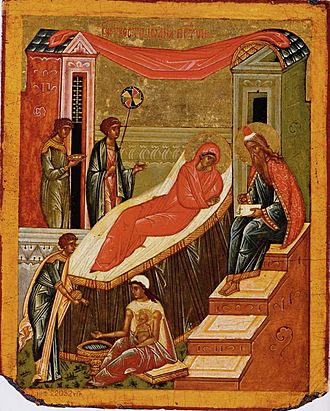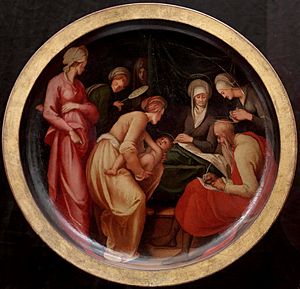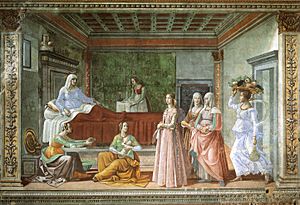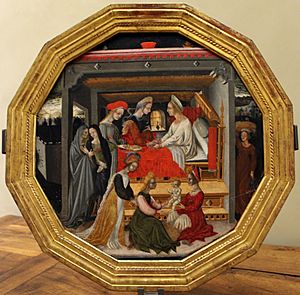Nativity of John the Baptist facts for kids
Quick facts for kids Nativity of John the Baptist |
|
|---|---|

Russian icon of the Nativity of John the Baptist
|
|
| Observed by | Eastern Orthodox Oriental Orthodox Roman Catholics Eastern Catholic Churches Lutherans Anglicans |
| Type | Christian |
| Significance | Celebrates the birth of John the Baptist, Jesus' precursor and relative |
| Celebrations | Religious services |
| Date | June 24 |
| Frequency | annual |
| Related to | Christmas Epiphany the Visitation Dehwa Daimana |
The Nativity of John the Baptist is a special Christian holiday. It celebrates the birth of John the Baptist, who was an important person in the Bible. People also call it the Birth of John the Baptist or St. John's Day. This day is celebrated every year on June 24. It's a very important day for many Christian churches, including Roman Catholic, Anglican, Eastern Orthodox, and Lutheran churches. The story of John the Baptist's birth is found in the Gospel of Luke in the Bible.
Contents
Why John the Baptist's Birth is Special

Christians believe that John the Baptist's life helped prepare the way for Jesus Christ. The story of his birth, found in the New Testament, is seen as a miracle. The Bible tells us that John's parents, Zechariah and Elizabeth, were very old and couldn't have children.
One day, while Zechariah was serving as a priest in the Temple in Jerusalem, the Archangel Gabriel appeared to him. Gabriel told Zechariah that he and Elizabeth would have a son. They were told to name him John. Zechariah found this hard to believe because of their age. Because he doubted, Gabriel made Zechariah unable to speak until the baby was born.
When the baby was born, everyone wanted to name him after his father, Zechariah. But Elizabeth said, "No, he will be called John." People were surprised because no one in their family had that name. So, they asked Zechariah, who was still unable to speak. He wrote on a tablet, "His name is John." As soon as he wrote this, Zechariah could speak again! He then praised God and spoke about Jesus' future work.
How the Day is Celebrated

The Bible also tells us that when the angel Gabriel told Mary she would have Jesus, he also mentioned that her cousin Elizabeth was already six months pregnant with John. Mary then went to visit Elizabeth. When Mary greeted Elizabeth, the baby (John) "leapt" in Elizabeth's womb.
The Nativity of John the Baptist is celebrated on June 24. This date is three months after the Annunciation (March 25), when Mary learned she would have Jesus. It is also six months before Christmas (December 25), which celebrates Jesus' birth. These dates help Christians remember these important events in a connected way throughout the year.
The celebration of John the Baptist's birth is one of the oldest Christian holidays. It was recognized as an important day as early as the year 506. Like Christmas, it was a day of rest and often celebrated with several church services.
Celebrations in Western Christianity
Usually, a saint's feast day is celebrated on the day they died. This is seen as their "birthday" into eternal life. However, there are two main exceptions: the birth of Mary and the birth of John the Baptist. In the Roman Catholic Church, it's believed that John was made free from original sin while still in his mother's womb.
The Nativity of John the Baptist is a very important church holiday in Catholic, Anglican, and Lutheran churches. In some places, like Quebec and Puerto Rico, it's even a public holiday.
Many famous artworks, especially from Florence, Italy, show the birth of John the Baptist. This is because John is the patron saint of Florence. These paintings often show the scene in a rich, everyday setting. One of the most famous examples is a large painting in the Tornabuoni Chapel in Florence, created by Domenico Ghirlandaio and his team.
The reformer Martin Luther wrote a hymn about baptism that is sung on this day. The composer Johann Sebastian Bach also wrote several pieces of music for this celebration.
Celebrations in Eastern Christianity
In the Eastern Orthodox Church and other Eastern Christian Churches, John the Baptist is often called St. John the Forerunner. This name means he prepared the way for Jesus Christ. His birth is celebrated on June 24 and is a major holiday.
Eastern Christian churches also celebrate other important days related to John the Baptist:
- January 7 – A main feast day for St. John the Forerunner.
- February 24 and May 25 – Days remembering when John the Baptist's head was found.
- August 29 – The day remembering when John the Baptist was beheaded.
- September 23 – The day remembering John the Baptist's conception and his parents, Zechariah and Elizabeth.
Customs and Traditions
You might wonder why the celebration is on June 24, not June 25, if it's exactly six months before Christmas. This is because of an old Roman way of counting days. They counted backward from the first day of the next month. So, "the eighth day before the Kalends of July" (July 1st) would be June 24, because June has 30 days.
Many people find it meaningful that this feast falls around the summer solstice (the longest day of the year). This reminds them of John the Baptist's words about Jesus: "He must increase, but I must decrease." This means Jesus' importance would grow, while John's would lessen.
Traditions Around Europe and Beyond
Across Europe, "Saint John's fires" are lit on mountains and hills on the evening before the feast. People used to believe that this day, as the first day of summer, was a "charmed" festival. Some old stories say that hidden treasures could be found, and certain herbs picked on this night had special healing powers. In Germany, these herbs are called Johanneskraut (St. John's herbs) and are brought to church for a blessing. In Scandinavia and Slavic countries, people believed that witches and demons were active on St. John's Day. To scare them away, children would go around asking for treats, straw figures were burned, and lots of noise was made.
In Tucson, Arizona, USA, "El Dia de San Juan" is celebrated. This day traditionally marks the start of the monsoon season. There's a legend that in 1540, the explorer Francisco Vázquez de Coronado prayed for rain on June 24, and it rained right after. Because John the Baptist baptized people in the Jordan River, people in Mexico and the American Southwest used to go to morning mass on June 24, then dip themselves fully clothed in the nearest water. In recent years, Tucson has worked to bring back the public celebrations of El Dia de San Juan.
In Mandaeism
The Mandaean religion also celebrates the birthday of John the Baptist. They call this holiday Dehwa Daimana. During this festival, children are baptized for the first time. It is celebrated on the first day of their 11th month, called Hiṭia.
See also
 In Spanish: Natividad de San Juan Bautista para niños
In Spanish: Natividad de San Juan Bautista para niños



